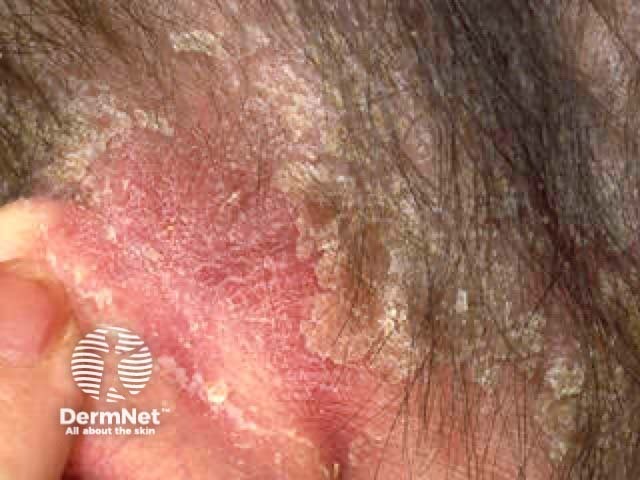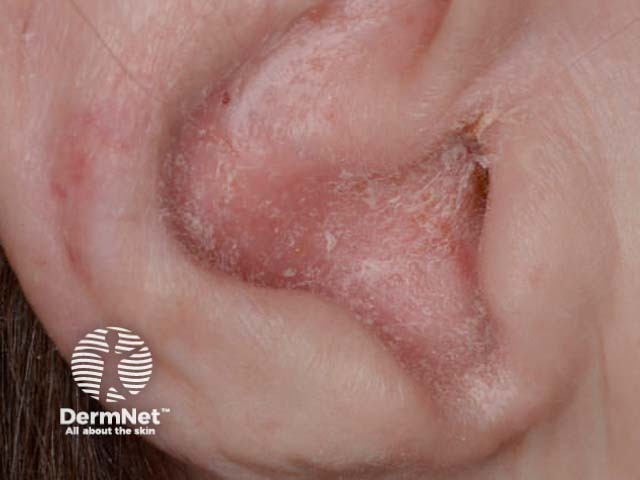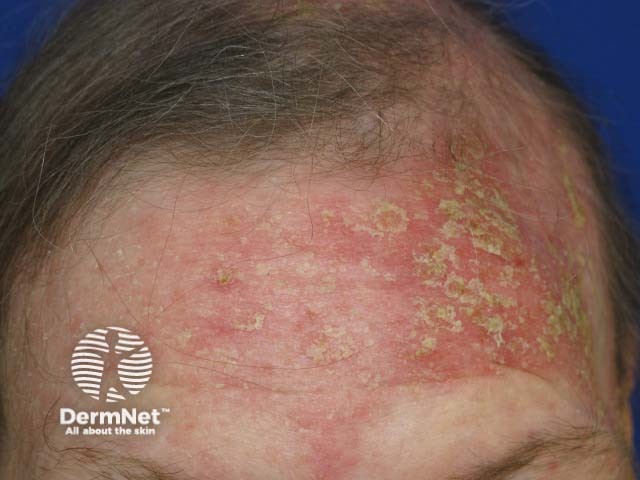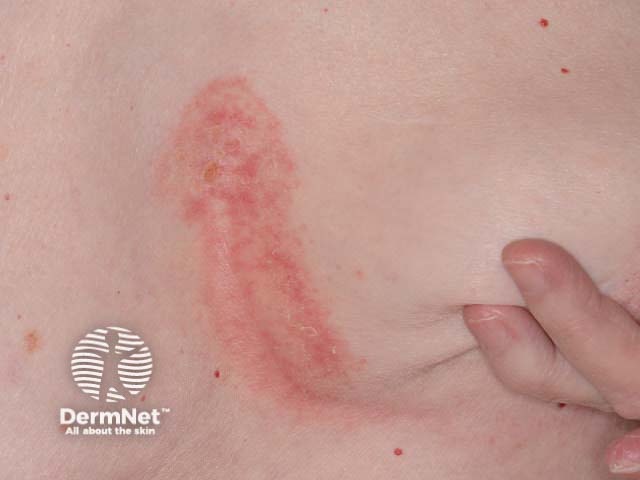Main menu
Common skin conditions

NEWS
Join DermNet PRO
Read more
Quick links
Sebopsoriasis — extra information
Sebopsoriasis
Author: AJ Sykes, medical registrar, Auckland. . Chief Editor: Dr Amanda Oakley, Dermatologist, Hamilton, New Zealand, June 2015.
Introduction Demographics Causes Clinical features Diagnosis Treatment Outcome
What is sebopsoriasis?
Sebopsoriasis is an overlap between two separate conditions: seborrhoeic dermatitis and psoriasis, in which features of both conditions co-exist. Sebopsoriasis can be thought of as a transitional condition between seborrhoeic dermatitis and psoriasis and has features of both conditions. The term is commonly used to describe a psoriasiform rash in a seborrhoeic distribution when the clinical features do not allow a precise diagnosis. Often it becomes clearer which condition the patient has with time and response to treatment
Who gets sebopsoriasis?
Sebopsoriasis can be seen across all age groups but is most common in childhood/adolescence and then increases in patients older than 50 years of age. The overall incidence is not known, as clear case definition is difficult.
Men are affected more often than women.
What causes sebopsoriasis?
Like seborrhoeic dermatitis and psoriasis, the pathogenesis of sebopsoriasis is not fully understood.
- Seborrhoeic dermatitis is thought to be due secondary to an abnormal immune response to Malassezia yeasts, a commensal organism, or their irritating metabolites.
- In sebopsoriasis, there appears to be a primary inflammatory dermatosis that results in increased cell turnover, scaling and epidermal inflammation, as seen in psoriasis.
- A family history of seborrhoeic dermatitis and/or psoriasis is often present.
Although the following factors are not present in the majority of patients with sebopsoriasis, they tend to be associated with more severe disease than in other patients without these risk factors:
- Immunosuppression (eg chronic liver disease, HIV/AIDS, medication)
- Neurological and psychiatric diseases, including Parkinson disease
- Disseminated malignant disease (cancer)
What are the clinical features of sebopsoriasis?
Sebopsoriasis is characterised by:
- Yellowish, greasy scale in typical seborrhoeic dermatitis areas (scalp, nasolabial folds, eyebrows, behind the ears and over the sternum)
- Deeper red, more defined margins and thicker scale than normally seen in seborrhoeic dermatitis
- Less silvery scale than seen in classic psoriasis
Sebopsoriasis can also affect skin folds (intertrigo).

Sebopsoriasis affecting the retroauricular skin

Sebopsoriasis of ear

Sebopsoriasis of forehead

Sebopsoriasis of chest
How is sebopsoriasis diagnosed?
Sebopsoriasis is diagnosed by its clinical appearance following a detailed history and examination. A skin scraping for mycology may reveal Malassezia, but this is not diagnostic, as the yeast is a normal component of skin flora (the microbiome).
Skin biopsy is rarely performed in sebopsoriasis. It shows histopathological features intermediate between psoriasis and seborrhoeic dermatitis.
How is sebopsoriasis treated?
The treatment for sebopsoriasis has overlap between the treatment for seborrhoeic dermatitis and that of psoriasis. Sometimes the response to treatment can help to determine if the patient is principally suffering from seborrhoeic dermatitis or psoriasis.
Emollients
- Emollients keep skin soft and prevent cracking.
- Topical keratolytics remove scale, eg urea, propylene glycol, lactic acid, salicylic acid.
- They also inhibit the growth of bacteria.
- However, excessive use of emollients encourages the growth of Malassezia, which might aggravate a seborrhoeic dermatitis component.
Topical antifungals
- Topical antifungals such as ketoconazole, ciclopirox and zinc pyrithione are very effective for seborrhoeic dermatitis but tend not to be helpful for psoriasis.
- Thus, topical antifungals have variable benefit in sebopsoriasis, depending on how much Malassezia yeasts are contributing to the condition.
- Combination therapy of topical corticosteroid and ketoconazole shampoo is more effective than ketoconazole shampoo alone.
- Oral antifungal agents such as itraconazole may help some patients with sebopsoriasis.
Topical corticosteroids
- Topical corticosteroids reduce the inflammatory response.
- There are various products available including shampoo, solution, gel, cream and ointment.
- Potent corticosteroid is used initially to gain control for a couple of weeks, then a lower strength preparation is used for long term management.
- The potency prescribed will depend on the body site being treated. Only mild to moderate potency topical corticosteroids are appropriate for face and skin folds, whereas a potent or ultrapotent product may be suitable for treating the scalp.
- Topical steroids are often used intermittently (eg at weekends only) rather than daily, to maintain efficacy and safety.
Topical calcineurin inhibitors
Topical calcineurin inhibitors Topical pimecrolimus cream or tacrolimus ointment may be helpful, especially if long term treatment is required and/or if there is concern about or presence of topical corticosteroid-induced side effects, for example, thin skin, easy bruising (purpura) or stretch marks.
Vitamin D-like compounds
- The vitamin D derivative, calcipotriol, reduces the inflammatory response and scaling in psoriasis and sebopsoriasis.
- Calcipotriol is not usually recommended for facial skin.
Coal tar products
- Coal tar products are often used for psoriasis and seborrhoeic dermatitis.
- Coal tar has keratolytic and anti-inflammatory effects.
- The scalp preparations can be especially helpful for some patients with sebopsoriasis.
- However, they can be messy and some people dislike the smell of coal tar.
Phototherapy
- Phototherapy can be effective for some patients with facial psoriasis, so could be considered for resistant sebopsoriasis
- However, phototherapy with ultraviolet radiation B (UVB) has not been found to be effective for most patients with sebopsoriasis.
- This is not surprising, because sebopsoriasis affects areas that are generally sun-exposed (face, scalp).
Systemic medications
- Methotrexate, acitretin and ciclosporin are used to treat severe psoriasis.
- They are rarely required for sebopsoriasis unless it is part of generalised psoriasis.
Biologics
- Biologics are increasingly used in the treatment of moderate to severe psoriasis.
- There is no data available currently in the use of biologics in the treatment of sebopsoriasis and it is not an indication for their use presently. They are unlikely to be required for sebopsoriasis.
What is the outcome in sebopsoriasis?
There have been no long term studies looking at the outcomes of patients with sebopsoriasis. It is a chronic disorder that relapses and remits from time to time and may evolve into more typical psoriasis.
References
- Dessinioti C, Katsambas A. Seborrheic dermatitis: etiology, risk factors, and treatments: facts and controversies. Clin Dermatol. 2013 Jul-Aug;31(4):343–51. DOI: 10.1016/j.clindermatol.2013.01.001. Review. PubMed PMID: 23806151.
- Ayala F. Clinical presentation of psoriasis. Reumatismo. 2007;59 Suppl 1:40–5. PubMed PMID: 17828342..
- Choczaj-Kukuła A, Kwaśniewska J. [Current possibilities of using antimyocotic drugs in the treatment of various skin disorders]. Wiad Parazytol. 2004;50(2):125-33. Review. Polish. PubMed PMID: 16859015..
- Nakayama J. Four cases of sebopsoriasis or seborrheic dermatitis of the face and scalp successfully treated with 1a-24 (R)-dihydroxycholecalciferol (tacalcitol) cream. Eur J Dermatol. 2000 Oct-Nov;10(7):528-32. PubMed PMID: 11056423.
On DermNet
Books about skin diseases
